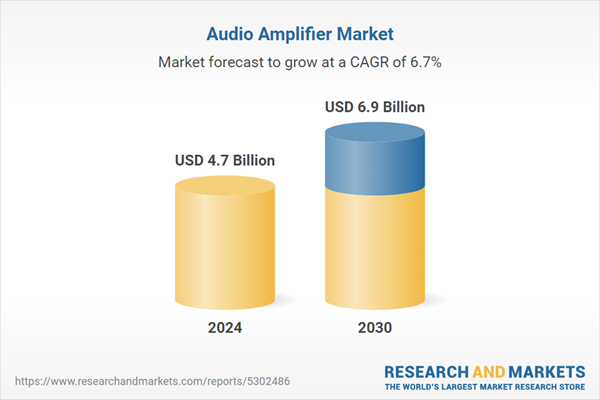The global market for Audio Amplifier was valued at US$4.7 Billion in 2024 and is projected to reach US$6.9 Billion by 2030, growing at a CAGR of 6.7% from 2024 to 2030. This comprehensive report provides an in-depth analysis of market trends, drivers, and forecasts, helping you make informed business decisions. The report includes the most recent global tariff developments and how they impact the Audio Amplifier market.
Segments: Device (Home Audio Systems, Smartphones, Television Sets, Desktops & Laptops, Other Devices); End-Use (Consumer Electronics, Automotive, Entertainment).
Geographic Regions/Countries: World; United States; Canada; Japan; China; Europe (France; Germany; Italy; United Kingdom; Spain; Russia; and Rest of Europe); Asia-Pacific (Australia; India; South Korea; and Rest of Asia-Pacific); Latin America (Argentina; Brazil; Mexico; and Rest of Latin America); Middle East (Iran; Israel; Saudi Arabia; United Arab Emirates; and Rest of Middle East); and Africa.
The analysts continuously track trade developments worldwide, drawing insights from leading global economists and over 200 industry and policy institutions, including think tanks, trade organizations, and national economic advisory bodies. This intelligence is integrated into forecasting models to provide timely, data-driven analysis of emerging risks and opportunities.
Global Audio Amplifier Market - Key Trends and Drivers Summarized
What Is an Audio Amplifier and How Does It Work?
An audio amplifier is an electronic device that boosts low-power audio signals to a level that can drive loudspeakers, allowing sound to be heard clearly and at high volumes without distortion. At its core, an audio amplifier takes a weak input signal, often from sources like smartphones, microphones, or musical instruments, and amplifies it to produce a more robust output. The process starts when an audio signal, typically measured in millivolts, enters the amplifier. Through a series of electronic components such as transistors, resistors, and capacitors, the signal’s amplitude is increased, resulting in a more powerful audio output. The amplifier essentially controls the gain, or the level of amplification applied, which is carefully regulated to prevent distortion and maintain sound quality. Different amplifier classes, including Class A, B, AB, and D, operate on varying principles and are suited to specific applications. For example, Class A amplifiers are known for their excellent sound fidelity but can be less energy-efficient, while Class D amplifiers use digital switching techniques to boost efficiency. By amplifying audio signals with precision, audio amplifiers ensure that sound is reproduced at an optimal volume and clarity, making them essential in home theaters, music venues, recording studios, and many consumer electronics.What Sets Audio Amplifiers Apart from Other Audio Equipment?
Audio amplifiers are unique in their ability to increase sound output power without compromising audio quality, a feature that distinguishes them from other types of audio equipment. Unlike mixers or equalizers, which primarily alter the tone or balance of audio signals, amplifiers focus solely on increasing the power of the signal itself, enabling speakers to reproduce sound at a higher volume and with better clarity. While audio systems contain multiple components, the amplifier is a central part of the sound chain, acting as the bridge between the audio source and the loudspeakers. Amplifiers come in various configurations, including integrated amplifiers, preamplifiers, and power amplifiers, each serving different functions within an audio system. For instance, integrated amplifiers combine the functions of a preamplifier, which prepares the signal for amplification, and a power amplifier, which increases the signal strength to drive the speakers. This integration makes them ideal for compact audio systems where space efficiency is key. In contrast, high-end audio systems often use separate preamplifiers and power amplifiers to provide greater control over sound quality and signal processing. Advances in amplifier technology, such as digital and hybrid amplifiers, have enhanced their performance and efficiency, further setting them apart in terms of power management, sound fidelity, and adaptability. This ability to amplify sound without introducing unwanted noise or distortion makes audio amplifiers essential in professional and consumer audio applications alike.How Have Audio Amplifiers Transformed Sound Experiences Across Applications?
Audio amplifiers have revolutionized how we experience sound in various settings, enhancing audio quality in everything from personal devices to large-scale sound systems. In home audio systems, amplifiers have enabled surround sound setups, which create immersive soundscapes for home theater enthusiasts. High-quality amplifiers used in these setups ensure that soundtracks, dialogue, and sound effects are delivered with clarity and precision, replicating the cinematic experience. In live music and entertainment venues, amplifiers play a critical role in delivering powerful, distortion-free sound across large spaces, ensuring that audiences receive clear audio regardless of their distance from the stage. Amplifiers have also become essential in recording studios, where accurate sound reproduction is critical for mixing and mastering tracks. Here, professional-grade amplifiers ensure that all frequencies are faithfully reproduced, helping artists and sound engineers craft high-quality audio productions. In portable devices, advancements in miniaturized amplifier technology allow for powerful sound output without sacrificing battery life, making it possible to enjoy high-quality audio on the go. Beyond traditional audio applications, amplifiers are also used in public address systems, helping deliver clear speech and sound in schools, airports, and public spaces. Across each of these settings, amplifiers have enhanced the sound experience, enabling higher quality and louder audio that meets the demands of various environments, from intimate gatherings to large public events.What’s Driving the Growth in the Audio Amplifier Market?
The growth in the audio amplifier market is driven by several factors, including advances in digital amplification technology, the increasing demand for high-quality sound in consumer electronics, and expanding applications in the automotive and entertainment industries. Digital and Class D amplifiers, which use advanced switching technologies, have improved amplifier efficiency, reducing power consumption while maintaining audio fidelity. This innovation is particularly valuable in battery-powered devices, such as smartphones, tablets, and Bluetooth speakers, where power efficiency is a key design factor. Additionally, consumer demand for high-fidelity audio in home entertainment systems, wireless speakers, and gaming consoles has led to greater adoption of amplifiers capable of delivering crisp, distortion-free sound. The automotive industry represents another significant growth driver, with car manufacturers integrating high-quality amplifiers into premium sound systems to enhance the driving experience. As electric vehicles and autonomous cars become more common, there is also a growing emphasis on in-cabin entertainment systems, which often feature sophisticated audio setups powered by efficient amplifiers. Furthermore, the rise of smart home systems and IoT devices has expanded the applications for audio amplifiers, as consumers increasingly seek seamless, high-quality audio across connected devices. These trends, combined with the ongoing development of compact, high-efficiency amplifiers, are fueling sustained growth in the audio amplifier market, as it continues to evolve in response to consumer expectations for superior audio experiences in diverse settings.Report Scope
The report analyzes the Audio Amplifier market, presented in terms of units. The analysis covers the key segments and geographic regions outlined below.Segments: Device (Home Audio Systems, Smartphones, Television Sets, Desktops & Laptops, Other Devices); End-Use (Consumer Electronics, Automotive, Entertainment).
Geographic Regions/Countries: World; United States; Canada; Japan; China; Europe (France; Germany; Italy; United Kingdom; Spain; Russia; and Rest of Europe); Asia-Pacific (Australia; India; South Korea; and Rest of Asia-Pacific); Latin America (Argentina; Brazil; Mexico; and Rest of Latin America); Middle East (Iran; Israel; Saudi Arabia; United Arab Emirates; and Rest of Middle East); and Africa.
Key Insights:
- Market Growth: Understand the significant growth trajectory of the Home Audio Systems segment, which is expected to reach US$2.2 Billion by 2030 with a CAGR of a 7.3%. The Smartphones segment is also set to grow at 6.9% CAGR over the analysis period.
- Regional Analysis: Gain insights into the U.S. market, valued at $1.2 Billion in 2024, and China, forecasted to grow at an impressive 10.2% CAGR to reach $1.7 Billion by 2030. Discover growth trends in other key regions, including Japan, Canada, Germany, and the Asia-Pacific.
Why You Should Buy This Report:
- Detailed Market Analysis: Access a thorough analysis of the Global Audio Amplifier Market, covering all major geographic regions and market segments.
- Competitive Insights: Get an overview of the competitive landscape, including the market presence of major players across different geographies.
- Future Trends and Drivers: Understand the key trends and drivers shaping the future of the Global Audio Amplifier Market.
- Actionable Insights: Benefit from actionable insights that can help you identify new revenue opportunities and make strategic business decisions.
Key Questions Answered:
- How is the Global Audio Amplifier Market expected to evolve by 2030?
- What are the main drivers and restraints affecting the market?
- Which market segments will grow the most over the forecast period?
- How will market shares for different regions and segments change by 2030?
- Who are the leading players in the market, and what are their prospects?
Report Features:
- Comprehensive Market Data: Independent analysis of annual sales and market forecasts in US$ Million from 2024 to 2030.
- In-Depth Regional Analysis: Detailed insights into key markets, including the U.S., China, Japan, Canada, Europe, Asia-Pacific, Latin America, Middle East, and Africa.
- Company Profiles: Coverage of players such as Analog Devices, Cirrus Logic Inc., Dialog Semiconductors, DIOO Microcircuits Co., Ltd., ICEPower A/S and more.
- Complimentary Updates: Receive free report updates for one year to keep you informed of the latest market developments.
Some of the 36 companies featured in this Audio Amplifier market report include:
- Analog Devices
- Cirrus Logic Inc.
- Dialog Semiconductors
- DIOO Microcircuits Co., Ltd.
- ICEPower A/S
- Infineon Technologies
- Integrated Silicon Solutions Inc. (ISSI)
- Maxim Integrated Product Inc.
- Monolithic Power Systems Inc.
- Nuvoton Technology Corporation
Tariff Impact Analysis: Key Insights for 2025
Global tariff negotiations across 180+ countries are reshaping supply chains, costs, and competitiveness. This report reflects the latest developments as of April 2025 and incorporates forward-looking insights into the market outlook.The analysts continuously track trade developments worldwide, drawing insights from leading global economists and over 200 industry and policy institutions, including think tanks, trade organizations, and national economic advisory bodies. This intelligence is integrated into forecasting models to provide timely, data-driven analysis of emerging risks and opportunities.
What’s Included in This Edition:
- Tariff-adjusted market forecasts by region and segment
- Analysis of cost and supply chain implications by sourcing and trade exposure
- Strategic insights into geographic shifts
Buyers receive a free July 2025 update with:
- Finalized tariff impacts and new trade agreement effects
- Updated projections reflecting global sourcing and cost shifts
- Expanded country-specific coverage across the industry
Table of Contents
I. METHODOLOGYII. EXECUTIVE SUMMARY2. FOCUS ON SELECT PLAYERSIII. MARKET ANALYSISSOUTH KOREAREST OF ASIA-PACIFICARGENTINABRAZILMEXICOREST OF LATIN AMERICAIRANISRAELSAUDI ARABIAUNITED ARAB EMIRATESREST OF MIDDLE EASTIV. COMPETITION
1. MARKET OVERVIEW
3. MARKET TRENDS & DRIVERS
4. GLOBAL MARKET PERSPECTIVE
UNITED STATES
CANADA
JAPAN
CHINA
EUROPE
FRANCE
GERMANY
ITALY
UNITED KINGDOM
SPAIN
RUSSIA
REST OF EUROPE
ASIA-PACIFIC
AUSTRALIA
INDIA
LATIN AMERICA
MIDDLE EAST
AFRICA
Companies Mentioned (Partial List)
A selection of companies mentioned in this report includes, but is not limited to:
- Analog Devices
- Cirrus Logic Inc.
- Dialog Semiconductors
- DIOO Microcircuits Co., Ltd.
- ICEPower A/S
- Infineon Technologies
- Integrated Silicon Solutions Inc. (ISSI)
- Maxim Integrated Product Inc.
- Monolithic Power Systems Inc.
- Nuvoton Technology Corporation
Table Information
| Report Attribute | Details |
|---|---|
| No. of Pages | 92 |
| Published | April 2025 |
| Forecast Period | 2024 - 2030 |
| Estimated Market Value ( USD | $ 4.7 Billion |
| Forecasted Market Value ( USD | $ 6.9 Billion |
| Compound Annual Growth Rate | 6.7% |
| Regions Covered | Global |









